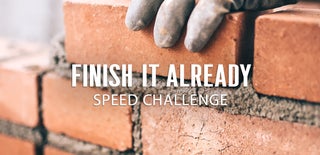Introduction: How to Design (and Finish!) a Wire Wrapped Moon Pendant
Hey Guys!
I was inspired by the "Finish it Already" challenge hosted by Instructables to finally finish this pendant that I had started planning literally over 2 years ago.
I was scrolling through the Instructables contest page and came across the challenge to finish a piece that was abandoned or forgotten. To say it called me out is an understatement. My worktable and drawers are FILLED with unfinished projects.
Two years ago I got into wire wrapping and jewelry making. I created several pieces but over time moved on to other projects. But today, as I was going through my supply drawers, I came across plans I had drawn out for a moon pendant as well as the moon. Although I had all the supplies, I never sat down to complete my sketches.
The saying goes, "better late than never," and I am forced to live by that or I'd get nothing done. In this Instructable, I will be showing you how to make your own moon pendant, and hopefully give you the motivation to finish it - unlike some of us..... :)
Step 1: Supplies
The Supplies needed for this project are as follows:
- 22 Gauge Wire (found at most craft stores relatively inexpensively)
- 28 Gauge Wire
- Wire Cutters
- Round Tip Pliers
- Needle Nose Pliers
- Moon Pendant (I bought mine at Hobby Lobby, but you can find many pendants online for under $5)
- Assorted Beads
- Determination to finish the project! :)
Step 2: Sketching the Design and Beginning the Frame
Its always good to sketch a design of your project before diving in, just to give yourself a visual idea of what you will be creating. It doesn't have to look pretty (as seen in my photos lol) but its very helpful to have it to scale. I traced my moon pendant to be sure the sketch and the actual design would be as similar in size and shape as possible.
Once this is complete, it is time to begin creating the skeleton of the piece. I used the 22 gauge wire for this, because it is thicker and stronger. You do not want to have soft wire for the frame or later on it will bend out of shape - a problem I had to figure out the hard way!
Some helpful tips:
- When bending wire that you wish to keep curved (such as a moon's shape), use round tipped pliers. Flat tipped pliers will inevitably cause harsh indents and creases in the wire.
- Tape the wire directly onto your sketch when building the skeleton. This ensures you will have the exact shape you want.
- When designing the back, start shaping the wire from the middle of the moon, not from the tips. A break in the wire is much easier to hide if it is in the middle, and behind, the pendant versus on the tip of the moon (See last photo for a better explanation).
Step 3: Begin the Curls
Im not actually sure what to call the curls inside the moon's face, but for the sake of explaining, I will call them spirals.
When creating these, Use the needle nosed pliers to wrap them into a curled shape. I used the 22 gauge wire for these as well. Be sure to refer to your design, and not make them too big or too small. You will need two, one for the top half of the moon and one for the bottom half. It isn't necessary to create any for the back of the pendant, but of course, you can if you want to!
Next, they must be attached to the moon's skeleton frame. I used the "over-under" wire wrapping technique to secure them using the very thin and bendable 28 gauge wire. The best way to understand this is to see the photos attached to this step. A picture paints a thousand words!
Step 4: Beginning to Attach the Skeleton
Now its time to begin attaching the front and back of the moon.
The photos show how to begin attaching the two together. Begin by attaching them at each of the tips. This keeps them from shifting in later steps when you add the pendant.
Again, the over-under technique is best for securing these, but I did a variation of alternately wrapping the wire twice on each side before going over and under twice. The first photo shows a simplified sketch of this.
Although it doesn't look pretty at first, this step is very important and is vital to the next steps.
Step 5: Continuing to Attach the Moon's Skeleton
Continue to wrap the 28 gauge wire over and under the moon's tips to secure it together. I didn't take this too far up the side of the moon, but you can take it as high as you would like.
Also, I wrapped wire over the place where the back of the moon connects to itself. This covered the sharp tips and cleaned up the connection.
Step 6: Adding the Pendant
This step was definitely the most frustrating and tedious, but paid off in the end!
Once the Moon's skeleton frame is connected at each end, it is time to add the pendant between them. Begin by using 28 gauge wire and going back and forth between the two. I started with the back side and went over and under again, using several smaller pieces of wire. Its much easier to use many small pieces than one large piece because it is prone to get tangled and break.
You will want at least 4 of these supports, two on each side of the moon. Furthermore, you will want to add wire in a triangular shape across the back of the moon. There was no pattern I used for this - rather I added wire where it was necessary to keep the pendant from falling out.
Once this step is complete, the pendant should be securely attached inside the moon's frame.
Step 7: Adding the Beads
To add the beads, they must have their own individual hoops. To create the loop, use the round nose pliers and wrap the wire around the loop (see photos).
You can, of course, use any beads you like, or no beads at all. I liked these ones because the red and silver went nicely with the blue moon.
Attach these to the top of the moon.
At this point, I had a lot of sharp wire ends poking out from all over the pendant. I tucked them in and cut them out using the wire cutters and flat head pliers. This not only makes the pendant more pleasing to look at, but it also doesn't snag on skin or clothing when wearing it.
Step 8: Finished!!
At this point, the pendant should be finished!!
You can add any other details you want, or leave it as it is (I added a chain).
Hopefully this is a project you can do within a couple of hours - and not a couple of years!!
It was very satisfying knowing that I finished one of the many projects laying around my work table. Now I just need to finish the others.....
If you make this piece, I'd LOVE to see photos! And if you have any questions or advice on improvements, please let me know in the comments!
Until next time,
~Elsie B.

Participated in the
Finish It Already Speed Challenge













